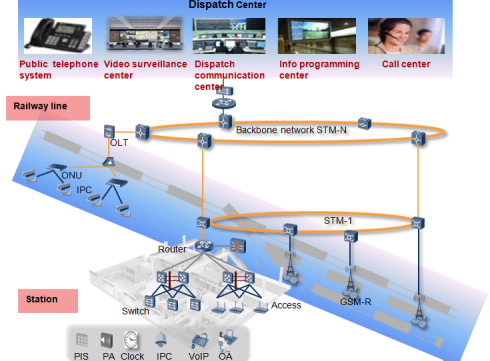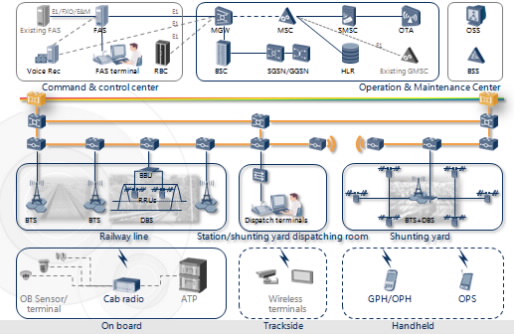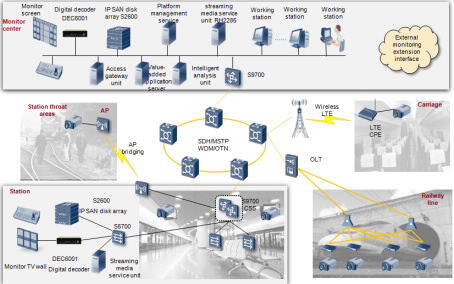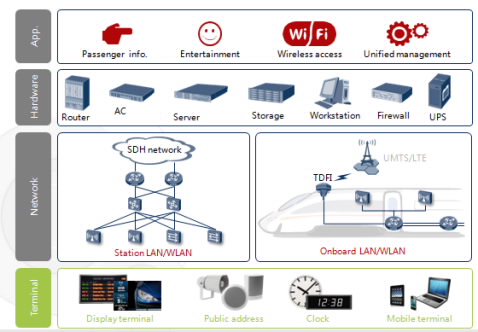Solución de ferrocarriles digitales de Huawei
Huawei's digital railway solution improves railway efficiency in a safe and reliable manner, effectively responds to the threats from natural disasters and terrorist attacks on the railway, and greatly enhances passenger experience and service satisfaction. Huawei's digital railway solution consists of sub-solutions for the operation communication, security video surveillance, and passenger service.
Railway Demand for ICT and Development Trend
Railway is the main artery of the national economy, the national critical infrastructure, and a tool of the public transport system. Railway transportation plays a crucial role in economic and social development. The trend of the railway industry is efficiency (fast passenger transportation and heavy freight), security (reliable production and free of worries), satisfaction (enhanced passenger travel experience). The railway business needs to address the following challenges:
- Improve the efficiency of railway transportation: With the rapid growth of national economy, passenger and freight railway traffic demand is growing quickly. However, the actual carrying capacity growth was significantly lower than the growth in demand due to poor capacity and inefficiency of the railway caused by long-term high load. Building new passenger-dedicated lines, heavy-freight railways, and electrification of existing lines is an effective means to improve efficiency.
- Improve disaster prevention measures: According to incomplete statistics, traffic accidents worldwide cause hundreds of billions of economic losses and serious casualties each year, among which, 5% and 10% of railway traffic accidents are caused by natural disasters and terrorist attacks, respectively. All these require effective disaster prevention measures to improve railway security-protection capabilities.
- Enhance passenger travel experience and service satisfaction: Passengers often face difficulties:
Troublesome ticketing: lack of real-time residual ticket checking mechanism, lack of diverse ticketing manners, and troublesome ticket refund or change
Poor customer service: few channels for complaints or inquiries and outdated service mode
Boring journey: no information or network services in railway stations
These problems affect passenger travel experience and service satisfaction.
Huawei's digital railway solution is developed based on a deep understanding of difficulties faced by the railway communications business and Huawei's leading railway ICT capabilities as follows:
- The railway communications system effectively improves the efficiency of railway transportation.
- The integrated security video surveillance system improves railway disaster prevention and mitigation capabilities.
- The passenger service system enhances the service level and passenger travel experience.
The solution helps railway operators to raise the overall level of railway informationization to meet challenges in developing the railway business.
Huawei's Digital Railway Solution
Overview
Huawei's digital railway solution consists of the following sub-solutions:
Operation communications solution: Integrate Global System for Mobile Communications - Railway (GSM-R), power supply, transport, and IP competitive products. This solution facilitates industry top suppliers for auxiliary products to build a highly reliable, flexible, and evolving operation communications system.
The video surveillance solution: Include the camera, access network, transport, wireless network, storage, platform, network energy, and third-party products. This solution ensures traffic safety between railway sections, passenger safety and freight security in railway stations, and operation security between intermediate stations and equipment rooms.
Passenger service solution (PIS/PA/clock/call center): Provide passengers with travel information, time, weather, and other multimedia information services all the time, and emergency information and instructions upon emergencies.
Note that PIS stands for passenger information system and PA stands for public address.

Figure-1 Overview of Huawei digital railway solution
Operation Communications Solution
Requirements
Based on more than 20 years' experience in the information and communication fields, Huawei fully understands the needs in railway communications business. As new technology develops, the railway industry based on dispatching using traditional wireless communication technologies is facing severe challenges:
Centralized dispatching: With the trend of efficient railway operations, the train departure interval is shortened and the demand for parallel dispatching communication grows significantly. However, the communication among the central dispatcher, station attendant, and train driver (big triangle communication) is still based on the traditional wireless communication technique single-channel analog, which fails to meet the requirements of wide-area dispatching and parallel calls.
High-speed passenger traveling and heavy freight: Trains need reliable and secure wireless communication networks to transmit security data (such as high speed train ETCS-2 train control data, synchronized operation data of heavy-loaded locomotives, and railway air brake data). However, data transmission capacity is insufficient in the traditional wireless communication system and the security measures are out of date. As a result, traffic security data cannot be transmitted in wireless networks.
Introduction
Huawei's operation communications solution integrates GSM-R, power, transmission, and IP competitive products. This solution facilitates industry top suppliers for auxiliary products to build a highly reliable, flexible, and evolving operation communications system.
The application scenarios include the following:
- Tunnels, marshalling stations, mountain areas, and other areas: Distributed base stations are used for signal coverage.
- New projects with high rental cost of laying fiber optic cables and disaster-prone road sections with network interruption tendency: The network uses the Hybrid MSTP to build rings and the microwave is applied to complete the unclosed rings.
- DWDM stands for dense wavelength division multiplexing.
- MSTP stands for multi-service transmission platform.
- Reconstruction projects with high rental cost of laying optical cables: Wavelength division is applied for capacity expansion, the network uses the MSTP technology to build rings, and microwave is used to complete the unclosed rings. These can improve the construction efficiency which is quite low in these projects.

Figure-2 Overview of Huawei operation communications solution
Highlights
Based on the design principles of high availability, reliability, and security, Huawei provides multiple unique techniques and protection mechanisms to ensure the security and reliability of the dispatching communication.
The unique patented automatic frequency control (AFC) algorithm and distributed base stations improve the handover success rate and reduces the handover occurrence, thereby improving the signal quality and preventing interruption of dispatching calls caused by call drops, degrading of signal devices, or stopping of trains.
The system supports full redundancy protection. The unique fast handover upon BSC faults effectively resist the single-point failure and improves the system disaster recovery capabilities.
OTN/MSTP technologies are applied in the backbone, convergence, and access layers to build the ASON for multi-level protection against the single-point and multi-point faults caused by natural disasters or human events.
OTN stands for optical transport network.
ASON stands for automatically switched optical network.
Network power uses bridgeless PFC, synchronous rectification, soft-switching technique, and optimum components are used for the fourth-generation rectifier module technique. The rectifier module failure rate is reduced to one third and no output derates under the operating temperature of 55 degree.
Based on rich experience in the communications industry and a deep understanding of the railway communications business, Huawei customizes highly flexible dispatching communication systems adaptive to the complex railway environment. The systems are easy to deploy and manage, reducing the site investment and operating expense.
The industry's only commercial distributed base stations are deployed for flexible network plan, deployment, management, and maintenance in the tunnels, mountain areas, and marshalling stations.
Unique techniques, such as intra-frequency co-site, dual-network coverage, and enhanced coverage improve the frequency utilization and reduce the investment in site construction.
The network uses the microwave to build and complete the rings for remote protection. 80% boards of the MSTP devices can be shared. These can reduce the investment in site construction and spare parts.
The network energy solution is applicable to all railway scenarios, such as indoor, outdoor, no mains supply, instable mains supply scenarios, thereby effectively reducing the operation expense.
Based on insights on communication industry trends and a full understanding of railway communications construction, Huawei provides a future-oriented dispatching communications system to protect existing investment and fully support smooth evolution.
The GL dual-mode base station supports working mode's smooth evolution from GSM to LTE, which is unique in the industry.
MSTP and microwave products support transition to all-IP networks.
Leading end-to-end (E2E) IEEE 1588v2 solution is used to meet the µs-level time synchronization requirement in LTE networks.
Network energy device components are compatible and the systems are extendible, supporting smooth network transition and upgrade.
Railway Security Video Surveillance Solution
Requirements
Railway transport is faced with threats from natural disasters, such as earthquakes, landslides, mudslides, floods, and terrorist attacks such as explosions and arson threat. The natural disasters and terrorist attacks cause serious accidents.
All the accidents require a complete security system for prevention, location, surveillance, and evidence collection. Building an intelligent video surveillance system is a top priority for railway security, and the following challenges need to be addressed:
Front end: Meet requirements in all station scenarios, such as high-definition for banknote currency check in ticket windows, clear display of train trip information, and electricity supply when no mains supply is available.
Network: Adapt to harsh environment along the railway lines, and ensure video access without fiber resources, access of real-time security video surveillance, and the bandwidth for important videos.
Monitoring center: Save storage space, and reduce investment. Fast read and write must be provided for convenience to facilitate high-level decision-making.
Intelligent applications: The intelligent analysis meets needs for disaster prevention, public security protection, and linkage to timely alarms.
Introduction
Huawei's integrated railway video surveillance solution uses high-definition cameras to monitor each scene of the railway. Different access methods are provided for different applications:
- Along railway lines, passive optical network (PON) access is applied when fiber resources are available and wireless access is applied when no fiber resources are available.
- Wifi access is applied to the throat areas near stations.
- Monitoring videos are returned between the train and the ground on LTE networks.
- Ethernet device access is used inside stations.
Videos are uploaded to the monitoring center through transmission networks for storage and check. Then, intelligent analysis and alarm processing are performed on the uploaded videos.

Figure-3 Overview of Huawei railway security video surveillance solution
Highlights
Multiple access methods ensure full coverage of stations, trains, and railway lines.
Wired (PON and switches) and wireless (3G, LTE, and Wifi) access methods facilitate video surveillance of stations and railway lines.
LTE is used for video return with a bandwidth of 30 Mbit/s when the train speed is 430 km/h, unique in the industry, provides real-time monitoring of trains.
Reliable product and solution design adapt to special railway application scenarios.
Industry-level PON supports a temperature from -40 to 85 degree to meet requirements in a harsh environment (hot/cold).
Video streaming is automatically assigned to prevent network congestion. The QoS ensures the quality of returning important videos. Multi-level network protection (board level, device level, network level) ensures safe return of videos.
Solar power provides backup power for 24 hours a day in three days, thereby addressing difficulty of no mains power along railway lines.
Efficient, easy to use, and investment-reducing
Intelligent analysis is performed on intrusion detection, illegal stays, and fixed-point security surveillance to achieve automatic linkage to light and sound alarms and processing. In other words, fast response is realized, saving manpower and improving the efficiency.
A maximum of 6 OS access methods are used for real-time display of video security surveillance at anytime and anywhere.
Huawei's patented optimized key-frame storage technology recognizes and periodically deletes non key-frames to free storage space, while reducing storage by 30%.
Passenger Service Solution
Requirements
Growing demand for travel information, entertainment, and online services on the journey
The passenger information system needs to bear a large volume of the video and audio, including text guidance, auto broadcasting, information service, ads, entertainment (stations and trains), interactive inquiry, and real-time info inquiry.
Unified deployment, operation and maintenance required by railway operators
- Deployment: Various deployment in diversified scenarios, such as indoor, outdoor, and online deployment are in demand due to the variety of interconnected system structures.
- Operation: Uninterrupted operations of terminals must be ensured upon faults in obtaining guidance info in different stations and regions.
- Maintenance: Unified surveillance is required for a large number of devices along the tracks for fast fault diagnosis and maintenance.
Introduction
Huawei's passenger service solution covers the surveillance center, infrastructure network, and terminal. This solution provides info services and wireless network services to improve travel experience, thereby enhancing travelers' comfort and satisfaction.

Figure-4 Overview of Huawei passenger service solution
Highlights
Huawei's passenger service solution provides the following advantages:
High-quality information services along the trips. Guidance and multi-media information service from base stations to trains, flexible choices of displays (terminals of different sizes and types) and contents based on passenger traffic, and advertisements programmed and broadcast on high-quality media platforms.
Integrated and open architecture. Different terminals and access devices share one network. The info service system is open and can be interconnected with other systems, such as the clock and CATV systems.
Efficient operations. Protection is achieved at the system, network, and power levels to provide uninterrupted services.
Why Huawei's Digital Railway Solution
Rich experience to develop a safe and reliable solution
- Huawei's GSM-R is applied to 50% of railways in China and our optical transmission products rank the first in the global market.
- Huawei has more than 10 years of experience with railway communication solutions.
- Huawei provides E2E ICT solutions.
- Huawei's digital railway solution provides products for the entire railway ICT business, covering the service application, network, and monitoring center.
Continuous evolution to protect clients' investment
- The evolution from GSM-R and LTE-R is supported.
- The transport network is continuously evolving from MSTP to Hybrid-MSTP.
- Video surveillance is displayed in higher definition screens and is more intelligent.
Attentive Service to enhance user experience
- Huawei has established service organizations around the world, thoughtfully providing consultancy, maintenance, and training services.
- Huawei listens to customers' needs to constantly provide more intelligent and automatic solutions.
Continuous product improvement and tool development reduce the operation and maintenance difficulties and enhance user experience.
